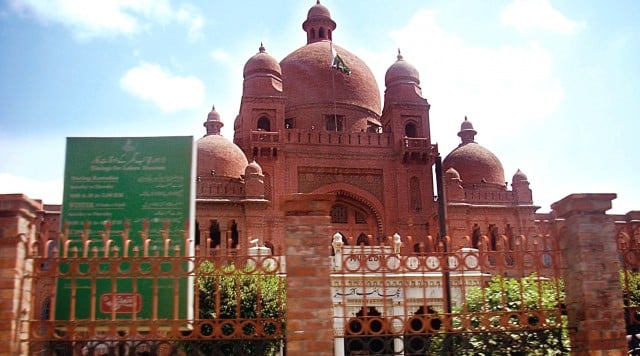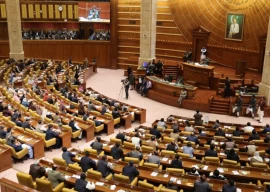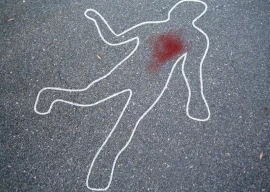
The museum boasts an impressive sprawling structure and despite the heat and the hurt this city has been suffering in the recent past, it still sees a spattering of visitors daily. I ask the guard, Farooq, and the souvenir shop, owner Liaqat, about how many people visit the building. They tell me the number has dropped drastically over the past couple of years. “We used to get many families but that has changed. Now we only get tourists or a couple of youngsters Sometimes one or two odd families make it in,” Liaqat tells me, adding that the situation has affected the canteen owners the most. Figures; food is usually the best barometer of how Lahoris feel in any given situation.
The building itself is a rather magnificent blend of the Mughal and the colonial. Domed and arched in the former tradition with a steady spattering of pre-colonial battle guns and the Queen’s crest in white marble budding along the boundary wall as a Unicorn and Lion glare at all visitors in an odd brand of defiance, despite having been silenced ‘technically’ for over six decades. A forgotten fountain, littered with…litter and pond scum stands testament to the administration’s lethargy but the structure itself still carries an odd, lingering aftertaste of former glory.
There is no air conditioning and the fans remain of the wall variety. The classic blue panelled ‘Royal’ fans that do little to encourage visitors to what is practically a furnace of historical artefacts, given that the museum also boasts a sun roof panelling along the entire building.
A glorious remnant of the most British-desi architecture, that takes the words ‘may the sun never set on the Empire’ far too literally for a race that gets more than its share of sun.
There are several highlights however: relics from the Graeco-Bactrian times as well as some Tibetan and Nepalese work; the Zamzama in front of the Museum, also known as Kim’s Gun from its appearance in Rudyard Kipling’s novel Kim; and the Fasting Buddha. Sculptures of the latter continue to attract Japanese tourists (and foreign aid – which is why we should be grateful they are among the few we haven’t bashed to bits). The sculpture represents the Brahman Alara Kalama. It symbolises the notion of ‘abstinence’ and the Buddhist ideal that the absolute attainment of our end is only to be found in abandoning everything.
The explanation comes from Bob from the Netherlands. Bob is perhaps the most obvious foreign tourist one is likely to come across in Lahore these days. I remind him that the city is hardly safe even for natives. Bob, who is in Pakistan for only a week, remains nonchalant.
“They (read Pakistani government) are doing what they can. No one can guard against suicide bombers all the time,” he says, taking swigs from his water bottle to keep himself hydrated. I ask him, what he thinks of the place and he says he is impressed with the collection; surprised at the scarcity of visitors and feeling a tad ‘hot’.
It is perhaps the politest way to infer that the Museum, ought to provide a more ‘friendly’ environment for visitors during the ‘summer’ vacations.
Bob tells me that he didn’t mind checking in his cell phone at the counter outside the main building but that he was surprised about the lack of security otherwise. “I saw that there were only two guards, and a female officer at the main gate and I thought either this place has been overlooked or it is safe,” he tells me, in what I simultaneously admire and scoff at as ‘foreign’ idealism. I wonder whether or not I should warn Bob about taking all possible precautions because my country is no longer ‘a safe place’. In the end, I don’t have the heart to do it. Also, I reason, he is here for only four more days. I shall keep my fingers crossed for him to make his way home safely and spread the false but fairytale rumour that ours is “a safe country, wonderful to visit”.
Asifa, one of the women working at the museum, asks if I am a journalist. When I confirm her suspicions, she says “I knew it, aap jese yahaan kam aatee hein.” Apart from being rather affronted and shocked at her implication, I ask her what she means. Asifa clarifies that the Museum isn’t really for upper crust ‘bajis’, adding “Yeh middle-class jagah hai baji.” My sense of despair is complete. Partly because I want desperately to denounce the label she has tagged on to me and mostly because I know she is right to point it out. I glance around the near empty halls of the museum, and realise that I am being stared … no, gawked at.
Apparently in this relic of reminiscence, I am the day’s headline.
I am uncomfortable as I leave the building and notice a lone, broken wheelchair by the door. I ask the guard what that is there for and he says it is to help cart around old or disabled visitors. “But it’s broken,” I remark, “Nahin ji, only one wheel is broken. It works perfectly otherwise,” he tells me. I will never, ever cease to marvel at our ability to negotiate with the facts that stare us in the face.
As I leave the grounds trying to decide whether wearing my ‘sunglasses’ will solidify my ‘upper crust baji’ image or whether I should opt for retinal scarring to fit in better, Farooq approaches me again. He tells me that security needs to be beefed up at the museum and I should ‘tell the media waalas’ that. “They are working to install cameras and check posts everywhere else but here everything stays the same.
There is a genuine fear that we could be a target, given that there are so many ‘Buddha’ statues in this museum,” Farooq tells me with a resentful sneer at meek Gautama, as if the dead pacifist messiah is to blame for the Taliban’s particular brand of ‘logical deduction’.
Farooq tells me that he feels the museum is ‘marked’ and I experience an odd tingle up my spine at my choice to re-work my column’s title to ‘Landmarked’: a decidedly risqué choice given our history.
Published in The Express Tribune, July 12th, 2010.


1672385156-0/Andrew-Tate-(1)1672385156-0-165x106.webp)




1732012115-0/Untitled-design-(14)1732012115-0-270x192.webp)









COMMENTS (1)
Comments are moderated and generally will be posted if they are on-topic and not abusive.
For more information, please see our Comments FAQ